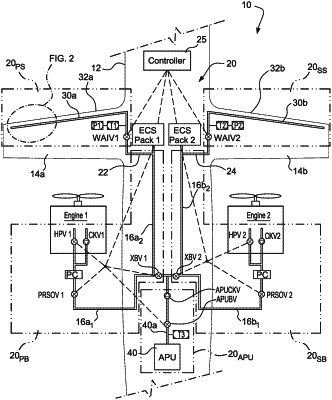| CPC B64D 15/04 (2013.01) [B64D 13/06 (2013.01); B64D 41/00 (2013.01); B64D 2013/0607 (2013.01); B64D 2013/0611 (2013.01); B64D 2013/0618 (2013.01); B64D 27/10 (2013.01)] | 11 Claims |

|
1. A thermo-pneumatic anti-icing system for a multiengine turboprop aircraft comprising:
(i) port and starboard pneumatic bleed air subsystems adapted to provide a supply of heated engine bleed air discharged from port side and starboard side turboprop engines of the aircraft;
(ii) port and starboard anti-icing subsystems operatively interconnecting the port and starboard pneumatic bleed air subsystems with port and starboard airfoils associated with the aircraft to thereby provide in-flight anti-icing protection to the port and starboard airfoils, respectively;
(iii) an auxiliary power unit (APU) capable of discharging a supply of heated APU bleed air to the port and starboard anti-icing subsystems;
(iv) normally closed port and starboard cross bleed valves XBV1 and XBV2 associated operatively with the port and starboard pneumatic bleed air subsystems and pneumatically connected to the APU so as to supply, when opened, heated APU bleed air to the port and starboard airfoils, respectively; and
(v) a controller which issues a control signal to either the XBV1 or the XBV2 in response to a single engine operational condition wherein one of the port or starboard pneumatic bleed air subsystems is incapable of delivering heated engine bleed air from the port side turboprop engine or the starboard side turboprop engine, respectively, the control signal thereby respectively opening the XBV1 or the XBV2 and allow the APU bleed air to be supplied to the one of the port anti-icing subsystem or the starboard anti-icing subsystem that is incapable of delivering heated engine bleed air from the port side turboprop engine or the starboard side turboprop engine, respectively, whereby the port and starboard airfoils are each protected against inflight icing during the abnormal single engine anti-icing operational condition.
|